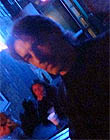|
|
 
|
|
Author
|
Topic: Technicolor Glendale film lab to close
|
Leo Enticknap
Film God

Posts: 7474
From: Loma Linda, CA
Registered: Jul 2000
|
 posted 12-21-2013 02:53 AM
posted 12-21-2013 02:53 AM





quote: Daily Variety, December 20, 2013
Technicolor’s decision to close its Glendale film lab shows just how quickly the photochemical film business is approaching extinction.
The lab, which employed 39 people, was devoted to processing 65mm negatives and striking 70mm prints for Imax and other large-format theaters. ”It’s clear the market has dropped, as you can imagine,” said Claude Gagnon, president of Technicolor Creative Services. “Imax has transformed a lot of their theaters to digital and we were even lucky to have another year, because the volume was very uncertain at the beginning of the year.”
Fotokem continues to offer 65mm/70mm services as well as 35mm and 16mm services, and Technicolor still has one film lab, in Bangkok. But photochemical developing and printing on an industrial scale is likely to vanish soon. “Is it six months? Is it three months? It’s not five years,” said Gagnon about the future of Technicolor’s Bangkok lab. Gagnon said some studios have said that sometime in 2014, there will be no more film prints.
Gagnon said the company’s HR department is working to place the affected employees elsewhere within the company but, “as you can imagine it’s very difficult to move people from a very analog activity to digital.” Technicolor employs 1,750 people in the Los Angeles area, he said.
Technicolor has been eager to shed its analog film legacy business for some time as it completes its transition to a digital services and post-production company. It even dropped any hint of film reels from its logo in favor of a logo suggesting digital level bars.
Sad but not surprising. I hope those affected manage to get back on their feet as quickly as possible.
| IP: Logged
|
|
|
|
|
|
|
|
|
|
|
|
|
|
|
|
Leo Enticknap
Film God

Posts: 7474
From: Loma Linda, CA
Registered: Jul 2000
|
 posted 12-25-2013 10:21 AM
posted 12-25-2013 10:21 AM





quote: Steve Kraus
You'd think there would be enough front end business for those still shooting on film, and processing preservation elements.
Lab work on production and preservation elements usually isn't done by the same people and departments as the mass-production of release prints, and often not even in the same facility. Archival lab work is usually done either in the big archives' in-house labs (e.g. UCLA, the Library of Congress and the BFI) or by small companies that focus specifically on this market (e.g. Film Technology Co. in Hollywood or PresTech in London).
These guys will make you a release print if you ask them to, but they'll give the job showprint attention to detail and QC, and charge you showprint prices. Sorry to bang on with this analogy, but it's the difference between one of the last vinyl albums to be made as it was winding down as a mainstream format, and a 180 gram audiophile pressing now. The few remaining labs that are doing a 200-300 print run using high speed panel printers and virtually boiling chemistry to get them through the processing quickly are, I would guess, now not being funded well enough (e.g. staffing levels had been reduced) to QC the temperature control, chemical replenishment and all the things that need to be got critically right in order to produce a high quality and consistent result. The glitch that Robert describes sounds to me like a printer malfunction of some sort, and after it was fixed no-one discarded the section of raw stock that was being printed at the time and that could have contained a bug. In the days when that print could have ended up in a high end, first run city centre venue, that reel would automatically have been rejected as a routine precaution.
| IP: Logged
|
|
|
|
|
|
|
|
Brent Francis
Film Handler
Posts: 84
From: Toronto Ontario Canada
Registered: Nov 2008
|
 posted 01-03-2014 06:29 AM
posted 01-03-2014 06:29 AM





Don't know how much I can disclose with a non-disclosure clause in my contract, but:
-Every single piece of film was inspected by human eyes (usually on a hi-speed machine running appx. twice normal speed - easy to see problems when you're used to it). The picture included sound tracks & perf. edges.
-Every 10th reel or so was a "red can" - screened regular speed with scanners built into the projector to measure sound and picture density, colour levels, movement, digtal and DTS clarity, etc. etc., and the result posted to our printing dept.
- If nothing else worked, you watched it all slow speed. I vividly remember watching a not-very-good trailer for one epic 45 times in a row.
So if you've ever had to sit at 4AM in a warm chair with a machine purring behind you, watching the same thing over and over AND not only staying awake but alert to problems, I think you'll agree we did a pretty good job!
(PS No IMAX, etc. except some 35 reduction prints. We were straight theatrical release).
| IP: Logged
|
|
|
|
All times are Central (GMT -6:00)
|
|
Powered by Infopop Corporation
UBB.classicTM
6.3.1.2
The Film-Tech Forums are designed for various members related to the cinema industry to express their opinions, viewpoints and testimonials on various products, services and events based upon speculation, personal knowledge and factual information through use, therefore all views represented here allow no liability upon the publishers of this web site and the owners of said views assume no liability for any ill will resulting from these postings. The posts made here are for educational as well as entertainment purposes and as such anyone viewing this portion of the website must accept these views as statements of the author of that opinion
and agrees to release the authors from any and all liability.
|

 Home
Home
 Products
Products
 Store
Store
 Forum
Forum
 Warehouse
Warehouse
 Contact Us
Contact Us




 Printer-friendly view of this topic
Printer-friendly view of this topic

















